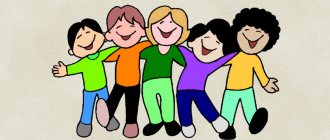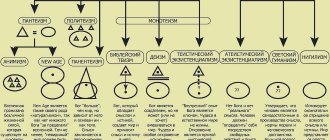In this article we will tell you:
- Interpersonal relationships in human interaction
- Features and examples of interpersonal relationships
- 5 principles of human interaction
- 4 types of human interaction
- 13 Tips for Building Positive Relationships
Human interaction is a relationship based on feelings, communication, and involves joint activities. They are based on social connections that already exist or emerge again between members of society. Verbal and non-verbal, spontaneous or gradual - there are many options.
As a rule, interpersonal relationships are established for a specific purpose: to receive some benefit, share emotions, feel support, learn or communicate something. Important components of such relationships are mutual trust and understanding.
Interpersonal relationships in human interaction
People interact with each other most often through three main methods of communication:
- verbal – information is exchanged using words and oral speech;
- nonverbal – non-verbal interaction: facial expressions, gestures, gaze, posture;
- affective – communication using sound expressions of emotions: laughter, crying, squealing and others.
A person begins to interact with other people immediately after birth. The child communicates with his parents using grimaces, laughter, crying, expressing his emotions and needs. Over time, he begins to realize what kind of reaction the parent receives to this or that manifestation. Of course, at the initial stage of life, the personality has not yet been formed, so it will be possible to talk about true interpersonal communication only when the child goes through the stages of initial socialization.
Your psychologist. The work of a psychologist at school.
| Communication as people's perception of each other |
| Communication as interaction |
| Types of Interpersonal Interaction |
| Communication style and I-statements |
| Mechanisms of psychological influence: suggestion, infection, persuasion |
| Means and techniques of psychological influence |
| Ethics of business communication |
| All pages |
Page 5 of 9
1.7. Types of Interpersonal Interaction
E. Berne identifies various forms of interpersonal interaction: affection, friendship, love, competition, care, pastime, surgery, play, social influence, submission, conflicts, ritual interaction and others. They are characterized by specific positions. One of the common forms is ritual interaction, which is built according to certain rules, symbolically expressing real social relations and the status of a person in a group and society. Ritual acts as a special form of interaction, invented by people to satisfy the need for recognition. In this case, the Parent-Parent relationship dominates. Thanks to such interaction, the value of the group is revealed, people express what affects them most, constitutes their social value orientations. The English scientist Victor Turner, considering rituals and rites, understands them as prescribed formal behavior, as “a system of beliefs and actions performed by a special cult association.” They are important for maintaining continuity between different generations in a particular organization, for preserving traditions and passing on accumulated experience through symbols. Ritual interaction is both a kind of holiday that has a deep emotional impact on people, and a powerful tool that maintains stability, strength, continuity of social ties, a mechanism for uniting people, increasing their solidarity. Rituals, rituals, and customs are capable of being imprinted on a subconscious level, ensuring the deep penetration of certain values into group and individual consciousness, into ancestral and personal memory. Humanity has developed many customs: religious rites, palace ceremonies, diplomatic receptions, military rituals, social events, holidays and funerals . Rituals include numerous norms of behavior: receiving guests, greeting acquaintances, addressing strangers, etc. A ritual is a rigidly fixed sequence of transactions, and they are carried out from the position of the Parent and addressed to the same position, allowing people to feel recognized. If a person’s need for recognition is not fulfilled, then aggressive behavior begins to develop. The ritual is precisely intended to remove this aggression, to satisfy the need to be recognized at least minimally. With another type of interaction - operations - the transaction is carried out from the position of Adult - Adult. We meet with them every day: at work, at school, when preparing food, renovating an apartment, etc. Having successfully completed an operation, a person is confirmed in his competence and receives confirmation from others. Labor interaction, distribution and implementation of professional. family functions, the skillful and efficient performance of these duties - these are the operations that fill people's lives. Competition is a form of social interaction where there is a clear goal to be achieved, and all the actions of different people are related to this goal so that they do not conflict. At the same time, the person does not come into conflict with himself, adhering to the attitude of another team player, although he has an inherent desire to achieve better results. than other team members. Since a person accepts the attitudes of other people and allows him to determine what he will do in accordance with some common goal, he becomes an organic member of his group, society, accepting its morality and becoming a significant member of it. In a number of cases, being in the same room with other people and performing seemingly joint activities, a person mentally remains in a completely different place, talks with imaginary interlocutors, and dreams about his own. This specific interaction is called grooming. This is a common and natural form of interaction, but it is still more often resorted to by people who have problems with interpersonal needs. If a person has no other forms of interaction left except care, then this is already a pathology - psychosis. The next type of approved fixed interactions is a pastime that provides at least a minimum of pleasant sensations and signs of attention from partners. Pastime is a fixed form of transaction designed to satisfy people's need for recognition. If this form is implemented from the Parent-Parent position, then most often it is expressed like this: everything that deviates from the norm is discussed and condemned (children, women, men, government, television, etc.). Or this may be the case when discussing the topics “Things” (comparing owned cars, televisions, etc.), “Who won yesterday” (football and other sports results) - this is the pastime of men; “Kitchen”, “Shop”, “Dress”, “Children”, “How much does it cost?”, “Do you know that she ...” - topics for women. During this process, partners and prospects for developing relations with them are assessed. Sustainable interaction between people can be caused by the emergence of mutual sympathy and attraction. Close relationships. Providing support and companionship (that is, we feel loved, approved, and encouraged by friends and loved ones) are associated with feelings of happiness. Studies have shown that such positive relationships improve health and reduce the likelihood of premature death. “Friendship is the strongest antidote to all misfortunes,” said Seneca. Forms of interaction such as friendship and love satisfy people's need for acceptance. They are outwardly similar to passing time, but in these cases the partner is fixed, and sympathy arises towards him. Friendship includes sympathy and respect; love differs from it by its enhanced sexual component, that is, it equals: sexual attraction + sympathy + respect. In the case of falling in love, there is only a combination of sexual attraction and sympathy. These forms of interaction differ from all others in that they necessarily contain hidden Child-Child transactions expressing mutual recognition and sympathy. People can discuss any problems they want, even on a completely adult and serious level, but in every word and gesture they will take into account: “I like you.” Some features are characteristic of all friendly and loving attachments: mutual understanding, dedication, pleasure from being with a loved one, care, responsibility, intimate trust, self-disclosure (discovering innermost thoughts and experiences in front of another person). “What is a friend? This is the person with whom you dare to be yourself,” noted F. Crane.
1.8. Syntonic model of communication
The name “syntonic” is derived from the word “syntonia”, which means: “To be in harmony with oneself and others.” The syntonic model of communication was developed within the framework of neurolinguistic programming (NLP). Neuro-linguistic programming is the result of a fusion of psychology, linguistics, mathematics; NLP techniques are successfully used in pedagogy, management, psychotherapy, and business. The syntonic model identifies the basic communication skills (determination of desired goals, sensory acuity, flexibility, congruence, rapport, resource state) and divides the process of mastering it into parts, or steps. If you want to successfully interact with people, you need to master these steps through specific practice exercises. The syntonic model of communication views communication as the result of a complex interaction between the processes of perception and thinking (perception + thinking = communication). The process of communication begins with perception; it is with its help that a person establishes contact with the world and people. Our senses are like five doors that we open to collect information about the surrounding reality. Our consciousness opens these “doors” in turn: for one person, first for pictures, then for smells, for another - first for sounds, then for touches. This is a very fast sequence. But. however, consistency. Our subconscious mind perceives information through all five channels simultaneously and receives much more information than our conscious mind. The syntonic model of communication is based on the idea that each person has his own “favorite door of perception” - that representative system that he trusts more than others. For example, if your favorite system is visual (visual), then you perceive and store the world in “pictures” in your memory. It has been established that the leading representative system is externally manifested in eye movements, choice of words used in communication, breathing patterns and even posture. If you know which representational system your communication partner prefers, you can use words that correspond to his “favorite” perceptual model. People with a visual model of perception easily understand some words, while people with an auditory (auditory) and kinesthetic model easily understand others. If you choose and use words correctly, in accordance with the leading representative system of the interlocutor, you will be considered a person with whom it is pleasant to communicate, with whom it is easy to establish contact and mutual understanding. How do you know which representational system a person prefers? To do this, you need to carefully watch him. The words he uses will say a lot. His nonverbal behavior will be even more eloquent: eye movements, tempo and timbre of voice, breathing, posture. This important information cannot be faked, it comes straight from the subconscious, it is only important to learn to recognize and use it. A person with a visual representational system, when about to say something, searches through pictures in memory to determine what is happening at the moment. This happens very quickly and his eyes are unfocused on a spot about 60 cm from his nose. If you stand directly in this place, you can prevent such a person from thinking: he may even get angry. In the speech of visual people, words of visual meaning predominate: “see”, “clear”, “colorful”. “I see what you mean,” etc. Their speech rate is higher than that of people with auditory and kinesthetic representational systems. A person with an auditory representational system, when about to say something, listens to his inner voice. It is difficult for him to make a choice: his inner voice constantly leads the discussion, not knowing what to give preference to. The person's stasis at this time is looking to the right or left, moving along the midline or going down and to the left. The speech of auditory people is dominated by the following words: “I’m listening to you”, “let’s discuss”, “what tone”, “intonation”, “screams”, etc. People with a kinesthetic representational system listen to their inner feelings before speaking , and their eyes involuntarily look down to the right. In the speech of kinesthetics, the dominant words are: “touch”, “touch”, “tangible”, “painful”, “heavy”, “I feel a problem”, “it’s hard on my soul”, etc. Another type is added to the classical triad of people - “rational people” or “computers” are those who react not to their sensations, but to designations, names, words, “labels” that designate all their sensations and images. Their eye movements are difficult to catch; they prefer to use words: “we need to figure it out,” “let’s analyze,” “systematize,” etc. Basic communication skills Determining the desired results. Communication without results is like a journey without a goal. The result is what you want to see, hear and feel. NLP offers four ways to clarify goals and turn them into results: 1) clarify the result (precisely define the desired result); 2) formulation of the result in a positive form, for example: “I want to be rich” - a positive positive form, “I don’t want to be poor” or “I don’t want to look funny” - these are results formulated in a negative form. And this is an unproductive way to communicate. In fact, there is no need for a person to strive for what he does not want. He is more likely to succeed if he strives for what he wants. Therefore, it is better to formulate it in a positive form; 3) isolating sensory indicators of the result; To do this, you need to answer the questions: “What will I see when I achieve the result?”, “What will I hear?”; 4) agreeing on results with a communication partner: most people will help you achieve your results if they simultaneously achieve their own. If you achieve results against the interests of others, you are manipulative and people will obstruct your success, openly or covertly. Those who manipulate others usually face the four “dragons”: resentment, blame, remorse and revenge. So, communication begins with clarifying the results. And immediately think about how you will coordinate your desires with the completely fair claims of your communication partner. Sensory acuity. Every person has a sensory sense that helps him see, hear, and feel changes in the behavior of his communication partner. Sensory sense is necessary to control the communication process, ensuring successful progress towards the result. Some signals in the interlocutor's behavior may suggest that the wrong step has been taken or that it is necessary to retreat a little in order to achieve the goal. The ability to consciously maneuver is especially necessary in confusing situations. Sensory acuity helps to notice the smallest changes in the behavior of the interlocutor: after all, a person’s internal thoughts and emotions are manifested through external behavior (body postures, swaying, head tilts, shoulder movements, hand gestures). There are also more subtle changes: in skin color, muscle tone, breathing rate, momentary trembling of the lower lip. These subtle unconscious visible reactions in NLP are divided into four groups: changes in skin color, changes in inhalation, changes in the lower lip, momentary changes in muscles. Unconscious visible reactions are valuable because they are not subject to a person's conscious control and therefore contain true information. These subtle changes are difficult to notice without proper training. When learning sensory work, you need to master three steps. 1. Fixing changes in human behavior (practice every day in observing people, but remember the rule: “Stop, listen, look, turn on your intuition, but do not rush to interpretation”). 2. Distinguishing patterns, i.e., repeating moments in human behavior. Look carefully at those who are nervous: some shift from foot to foot, turn pale, others quickly pace around the room, clench their fists, bite their lips. And this happens every time in moments of nervous experiences. Such repeated specific changes in body posture, movements of the head, arms, legs, facial coloring, breathing rhythm, voice tempo are called patterns. 3. Calibration, i.e. recognizing a certain state of a person by his non-verbal signals, establishing a connection between the external pattern of a person’s behavior and his internal state. (At first, while you have little experience, you can clarify this with your interlocutor. Were you nervous when you said: “No need for sugar?” And to yourself you can add: “And you had pale spots on your face, you were shifting and listening to something.” .) NLP experts warn that you can fall into a dangerous trap if you interpret changes in the external behavior of the interlocutor based on your experience. The same external reaction can have completely different meanings for different people. Each person is individual and generalizations must be avoided. Flexibility. The communication process largely depends on the flexibility of the interlocutors - the ability to change their behavior depending on the circumstances, to respond to the behavior of their partner. Learning to be flexible means gaining the ability to see in a partner’s behavior the peculiarities of his perception and thinking and, by varying your behavior, achieve mutual understanding and achieve your goals. The NLP rule says: “If what you do doesn’t work, try something else.” In communication, it is important to be flexible in words, thinking, perception and behavior. Sensory acuity allows you to be flexible in perception. Flexible behavior has advantages: new behavior provokes new responses and... Perhaps you will achieve the desired result by using different new ways of behavior. To gain flexibility, you need to master three steps: 1 - interrupt old patterns of behavior (for example, take a different route to work, or in situations where there is no risk, stop what you are doing and think of three new possible ways to achieve it the same result, or, for example, do not speak for one week, write notes warning family and friends that you are conducting an experiment); 2 - invention and use of new opportunities and new ways of behavior. (For example, look at the world through new glasses, imagining for an hour that you are not you at all, but your neighbor on the landing. What does the world look like from his point of view? Imagine ages - 17 and 39 years old. What does life seem like to you at 17 years? And at 39?); 3 - a rapid sequence of interrupting old patterns of behavior and using new choices (for example, when you notice that the inner voice orders you: “You must!” - change your behavior, play a different role, be someone else for at least three minutes Or another exercise: in the middle of an argument, step back and tell your interlocutor: “You are completely right. What do you want now?”). Congruence. The word "congruence" comes from the Latin "congruens", which means "to meet and agree." Each of us has many different “parts”: a business person, a boss, a parent, a critic, a player, an ambitious person, a merry fellow, a conqueror of hearts, etc. If all parts of the personality act in concert, they unite, directing their efforts to achieve a result that is important to us. everyone, while choosing a single way of interaction - you are congruent. If we say one thing, do another, and want something completely different, then we are incongruent and our state is noticeable to the people around us. If parts of our personality have not yet decided what we really need, if there are any contradictions and disagreements about how to achieve results, we may say “yes”, but at the same time we will involuntarily shake our heads negatively, and a serious phrase may unexpectedly end with a short laugh . All this is seen by the people with whom we communicate, and this behavior causes confusion, doubt, and mistrust of us. As a result, the chances of successfully achieving results decrease. To be congruent is to take an important step towards achieving inner integrity. The syntonic model not only emphasizes the importance and necessity of congruence, but also offers six steps to master it: 1 - distinguishing between states of congruence and incongruence in order to recognize your state of congruence (a state of 100% involvement, focusing all forces on the task at hand) and incongruence (a state of internal confrontation, conflict with oneself, contradiction of desires, words, thoughts and deeds); 2 - getting to know different parts of your personality. This step is extremely important, since the most difficult problems for a person arise when some parts of his personality are not familiar with each other and do not even know that they are in conflict. In order to avoid such troubles, NLP experts suggest that a person realize and write down what roles he plays in his life, what desires he has, what parts of his personality are characteristic of him, and give them a name (name): for example, wife, mother, the ambitious part, the creative part, the cook, the production and business part, the coquette, the seductress who protects honor, the adventurer, the playful part, etc. Then it is useful to hold a “general meeting” of the main parts of your personality, and it is important to “see” and “hear” ", "feel" each part. How does she usually announce her existence? How do you feel it in your body? Where does it live - in the head, in the hands, in the legs? What might she look like? 3 - Determining the goals, intentions and desires of each part of the personality is a very important step towards congruence. We can only be congruent when we know exactly what we want. what results are we aiming for? At the same time, it is necessary to remember that all our parts, in one way or another, want our good and express our desires. We most often do not realize the full complexity of our inner life, and therefore we must give the floor to each part so that they reasonably declare their desires and what goal they are pursuing; 4 - determination of priority goals, i.e. you should determine what you need to achieve first of all, what goal may be the most important at present and in the future; 5 - achieving agreement between different parts of the personality that they recognize the established priority of goals - only then will you be congruent in your actions, gestures, intonations, in the choice of words and your communication will maximize the achievement of the desired results; 6 - concluding a “contract” on an accepted agreement (concluding a contract consolidates the agreement reached, shows respect for parts of the individual and is a guarantee that negotiations and the time spent on them are not just entertainment, but serious work). So, before you start any important task, check what condition you are in. And if you recognize the signals of incongruity, negotiate with yourself, with your parts of personality, try to reach agreement between them, draw up a written agreement on the issue under discussion and instruct the conscious part to monitor the decision made. If you learn to create harmony between the parts of your personality, you will notice how much more effective your communication, your activities and your overall life will become.
<< Previous — Next >>
Features and examples of interpersonal relationships
The social interaction of people has a number of features:
- Interpersonal relationships are strongly influenced by evaluative emotions, including unconscious ones. This applies not only to close relationships, but also to formal, business ones.
- Each of the parties involved in the interaction acts as a unique individual, who has his own character traits and social status.
- Relationships are characterized by gradual development with various types of communication - they are not spontaneous.
- The nature of interpersonal communication is changing. It is not static and can transform in the exact opposite direction, improve or worsen.
Description of communication models
The structure of communication determines the patterns of communication. Some people are more sociable, love to be in company and can talk for hours about nothing, while others are closed, prefer internal dialogues to external ones, talk little and only about business.
Sociability as a character trait develops, you can improve communication skills, the ability to objectively perceive people and interact effectively with them.
Communication patterns, as a rule, are formed in childhood or adopted from parents. Also, communication patterns can be determined by the specifics of the position held and even be a sign of professional deformation of the individual (for example, a teacher communicates with relatives, as well as with students).
COMMUNICATION MODELS:
- "Mont Blanc". Aloof, cold interlocutor. He focuses on the communicative side of interaction; he is not interested in interactions.
- "Chinese Wall". A person who considers himself higher and more significant than others. Perceives others as less successful/beautiful/smart people, which makes it difficult to interact with him.
- "Locator". A person who chooses a narrow circle of friends. Often one loved one or close friend is enough for him.
- "Grouse". A very uncommunicative person who creates only the appearance of communication and interaction. At the same time, the structure of Teterev’s internal communication with himself is preserved and oversaturated with dialogues and introspection.
- "Hamlet". Social perception is extremely important for this type of communication model. He tries to make the best impression, which is why he often plays to the public.
- "Robot". This person talks and acts “dryly”, unemotionally, always knows what, when and why to do or not to do.
- "Egoist". A person speaks only about himself, all his actions are aimed at obtaining personal gain.
- "Ally". The best form and type of communication, as it is two-way. The interlocutors are interested in productive interaction, take into account personality, strive to understand each other and come to an agreement.
Description of types of communication
The concept of “type of communication” is close to the concept of the model. Types of communication, as well as models, are used to indicate the characteristics of communication.
Types of communication:
- Mentorsky. With this type of communication, a person constantly teaches, instructs, and subjugates his interlocutor.
- Informative. A type of communication that is simply a relay of information, without the ability or desire to receive feedback.
- Inspiring. The individual participates in the fate of the interlocutor, supporting him, guiding him, helping him, advising him. With this type of communication, there is a productive dialogue, cooperation, and mutual assistance between the subjects of the relationship.
- Confrontational. Unlike other forms of communication, it involves discussion, dialogue with an opponent, constructive criticism with the goal of finding the truth through confrontation between personal subjective and objective views, reality.
Types of communication are needed in order to be able to select the most appropriate methods of communication in different situations: persuasion, suggestion, infection, request, coercion, ignoring and even manipulation.










